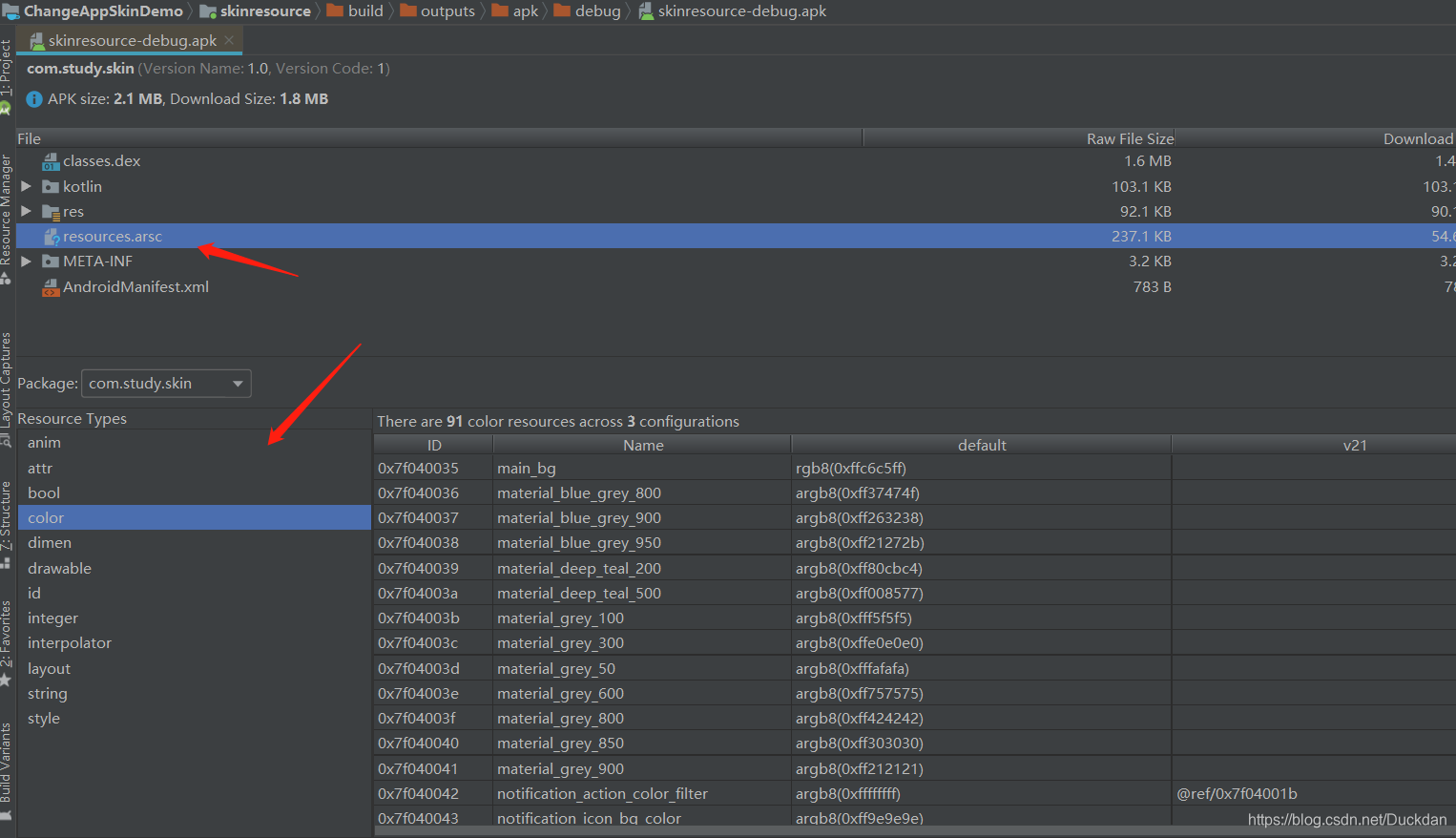源码版本:Android 9
编译环境:AndroidStudio3.5.3
针对Androidx
一、插件化换肤
何为插件化换肤,顾名思义,就是通过插件的形式向宿主Apk添加资源(图片/颜色等资源)。宿主apk进行资源应用,最终将宿主apk上面的资源替换掉。二、换肤时机
在进行换肤之前,我们需要了解Andorid布局文件的解析流程,具体可以查看 setContentView源码解读。三、源码分析
3.1 控件的生成
通过查看 setContentView源码解读可以知道,我们进行换肤的核心操作就是替换LayoutInflater类中的mFactory2变量。虽然mFactory2在Activity启动之前已经被赋值了,不过LayoutInflater给我提供了修改mFactory2的入口( setFactory2方法)。 setFactory2方法源码如下:public void setFactory2(Factory2 factory) {
//调用setFactory2方法一次之后,再次调用时将会抛出异常
if (mFactorySet) {
throw new IllegalStateException("A factory has already been set on this LayoutInflater");
}
if (factory == null) {
throw new NullPointerException("Given factory can not be null");
}
//第一次调用之后mFactorySet将会被赋值为true,所以要想实现插件化则必须在调用setFactory2中之前修改mFactorySet的值
mFactorySet = true;
if (mFactory == null) {
mFactory = mFactory2 = factory;
} else {
mFactory = mFactory2 = new FactoryMerger(factory, factory, mFactory, mFactory2);
}
}
通过分析上述源码可以知道,要想二次给mFractory2赋值成功则必须要将mFractorySet的值修改为false。
3.2 Apk中的资源的加载流程分析(Android8.0 Api26)
先来一张apk中的资源关系图,如下所示:
此处用Android8.0的源码来作分析,因为Demo中使用的Api接口是基于Android8.0的。在Android8.0之后Demo中用到的Api有些已经被谷歌标注为过时了,不过目前仍然可以用。资源加载的入口源码如下:
private void handleBindApplication(AppBindData data) {
//...不相关代码
//ContextImpl.createAppContext核心代码
final ContextImpl appContext = ContextImpl.createAppContext(this, data.info);
//...不相关代码
if (ii != null) {
//...不相关代码
final LoadedApk pi = getPackageInfo(instrApp, data.compatInfo,
appContext.getClassLoader(), false, true, false);
final ContextImpl instrContext = ContextImpl.createAppContext(this, pi);
//...不相关代码
} else {
//...不相关代码
}
//...不相关代码
}
上述ContextImpl.createAppContext方法源码如下所示:
static ContextImpl createAppContext(ActivityThread mainThread, LoadedApk packageInfo) {
ContextImpl context = new ContextImpl(null, mainThread, packageInfo, null, null, null, 0,
null);
//设置资源,packageInfo.getResources()核心代码
context.setResources(packageInfo.getResources());
return context;
}
上述packageInfo.getResources方法源码如下所示:
public Resources getResources() {
if (mResources == null) {
//创建resource
mResources = ResourcesManager.getInstance().getResources(null, mResDir,
splitPaths, mOverlayDirs, mApplicationInfo.sharedLibraryFiles,
Display.DEFAULT_DISPLAY, null, getCompatibilityInfo(),
getClassLoader());
}
return mResources;
}
上述ResourcesManager.getInstance().getResources源码如下所示:
public @Nullable Resources getResources(@Nullable IBinder activityToken,
@Nullable String resDir,
@Nullable String[] splitResDirs,
@Nullable String[] overlayDirs,
@Nullable String[] libDirs,
int displayId,
@Nullable Configuration overrideConfig,
@NonNull CompatibilityInfo compatInfo,
@Nullable ClassLoader classLoader) {
try {
//...不相关代码
return getOrCreateResources(activityToken, key, classLoader);
} finally {
Trace.traceEnd(Trace.TRACE_TAG_RESOURCES);
}
}
getOrCreateResources方法源码如下所示:
private @Nullable Resources getOrCreateResources(@Nullable IBinder activityToken,
@NonNull ResourcesKey key, @NonNull ClassLoader classLoader) {
synchronized (this) {
//...不相关代码
ResourcesImpl resourcesImpl = createResourcesImpl(key);
//...不相关代码
if (resourcesImpl != null && resourcesImpl != resources.getImpl()) {
//给resources设置ResourceImpl对象
resources.setImpl(resourcesImpl);
}
return resources;
}
}
上述createResourcesImpl方法源码如下:
private @Nullable ResourcesImpl createResourcesImpl(@NonNull ResourcesKey key) {
final DisplayAdjustments daj = new DisplayAdjustments(key.mOverrideConfiguration);
daj.setCompatibilityInfo(key.mCompatInfo);
final AssetManager assets = createAssetManager(key);
if (assets == null) {
return null;
}
final DisplayMetrics dm = getDisplayMetrics(key.mDisplayId, daj);
final Configuration config = generateConfig(key, dm);
final ResourcesImpl impl = new ResourcesImpl(assets, dm, config, daj);
if (DEBUG) {
Slog.d(TAG, "- creating impl=" + impl + " with key: " + key);
}
return impl;
}
上述createAssetManager方法源码如下所示:
protected @Nullable AssetManager createAssetManager(@NonNull final ResourcesKey key) {
AssetManager assets = new AssetManager();
if (key.mResDir != null) {
//assets加载资源
if (assets.addAssetPath(key.mResDir) == 0) {
Log.e(TAG, "failed to add asset path " + key.mResDir);
return null;
}
}
if (key.mSplitResDirs != null) {
for (final String splitResDir : key.mSplitResDirs) {
//assets加载资源,添加资源报的路径
if (assets.addAssetPath(splitResDir) == 0) {
return null;
}
}
}
if (key.mOverlayDirs != null) {
for (final String idmapPath : key.mOverlayDirs) {
assets.addOverlayPath(idmapPath);
}
}
if (key.mLibDirs != null) {
for (final String libDir : key.mLibDirs) {
if (libDir.endsWith(".apk")) {
//assets加载资源
if (assets.addAssetPathAsSharedLibrary(libDir) == 0) {
}
}
}
}
return assets;
}
3.3 如何通过Resources对象回去Apk中的资源
宿主加载插件的资源的简易效果图如下所示:
举个例子通过Resources对象回去apk中文本资源,代码如下:
val appName = resources.getText(R.string.app_name)
上述getText的源码如下所示:
public CharSequence getText(@StringRes int id) throws NotFoundException {
//关键语句,可以看到获取资源的操作实质是通过AssertManager完成的
CharSequence res = mResourcesImpl.getAssets().getResourceText(id);
if (res != null) {
return res;
}
throw new NotFoundException("String resource ID #0x"
+ Integer.toHexString(id));
}
AssertManager中获取资源id的四大核心方法如下所示:
//获取资源id
/*package*/ native final int getResourceIdentifier(String name,
String defType,
String defPackage);
//通过资源id获取资源名称
/*package*/ native final String getResourceName(int resid);
//通过资源id获取包名
/*package*/ native final String getResourcePackageName(int resid);
//通过资源id获取类型名
/*package*/ native final String getResourceTypeName(int resid);





 本文深入探讨插件化换肤技术,通过修改LayoutInflater的mFactory2变量实现资源替换,详细解析Android布局文件的解析流程及Apk资源加载机制。
本文深入探讨插件化换肤技术,通过修改LayoutInflater的mFactory2变量实现资源替换,详细解析Android布局文件的解析流程及Apk资源加载机制。
















 1129
1129

 被折叠的 条评论
为什么被折叠?
被折叠的 条评论
为什么被折叠?








